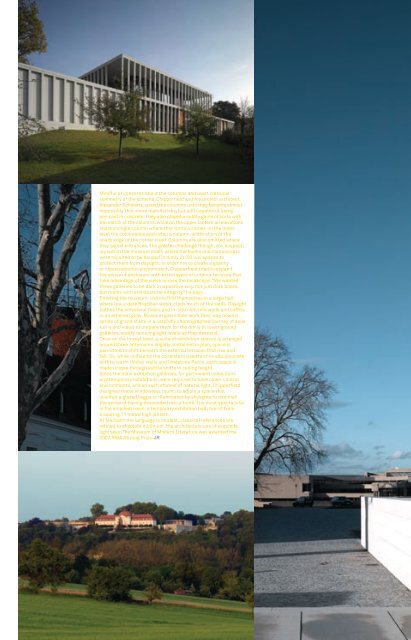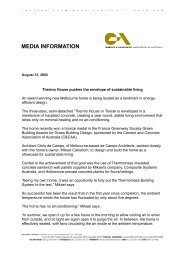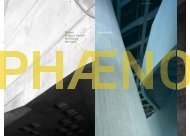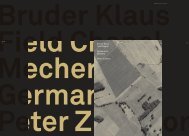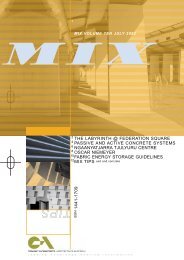Museum of Modern Literature Marbach, Germany David Chipperfield
Museum of Modern Literature Marbach, Germany David Chipperfield
Museum of Modern Literature Marbach, Germany David Chipperfield
Create successful ePaper yourself
Turn your PDF publications into a flip-book with our unique Google optimized e-Paper software.
Mindful <strong>of</strong> concerns about the columns and overt classical<br />
symmetry <strong>of</strong> the scheme, <strong>Chipperfield</strong> and his project architect,<br />
Alexander Schwartz, pared the columns until they became almost<br />
impossibly thin, mere matchsticks, but still capable <strong>of</strong> being<br />
pre-cast in concrete. They also played a subtle game <strong>of</strong> sorts with<br />
the march <strong>of</strong> the columns: while on the upper lantern all elevations<br />
share a single column where that turns a corner, on the lower<br />
level the colonnades each stop a column-width short <strong>of</strong> the<br />
sharp edge <strong>of</strong> the corner itself. Columns are also omitted where<br />
they signal entrances. The greater challenge though, you suspect,<br />
lay within the museum itself, where the books and manuscripts<br />
were required to be housed in dimly lit (50 lux) spaces to<br />
protect them from daylight. In order not to create a gloomy<br />
or claustrophobic environment, <strong>Chipperfield</strong> tried to expand<br />
the sense <strong>of</strong> enclosure with extra layers <strong>of</strong> outdoor terraces that<br />
take advantage <strong>of</strong> the views across the landscape. “We wanted<br />
these galleries to be dark in a positive way, not just dark boxes,<br />
but rooms with architectural integrity,” he says.<br />
Entering the museum, visitors find themselves in a large hall<br />
where Ipe, a dark Brazilian wood, clads much <strong>of</strong> the walls. Daylight<br />
bathes the limestone floors and in-situ concrete walls and s<strong>of</strong>fits<br />
in an ethereal glow. <strong>Museum</strong> goers then work their way down a<br />
series <strong>of</strong> grand stairs in a carefully choreographed journey <strong>of</strong> axial<br />
turns and views to prepare them for the dimly lit lower ground<br />
galleries, subtly reducing light levels as they descend.<br />
Once on the lowest level, a suite <strong>of</strong> exhibition spaces is arranged<br />
around three anterooms. Rigidly contained in plan, space is<br />
permitted to shift beneath the external terraces that rise and<br />
fall. So, while unified by the consistent palette <strong>of</strong> in-situ concrete<br />
s<strong>of</strong>fits, warm timber walls and limestone floors, each space is<br />
made unique through subtle shifts in ceiling height.<br />
Since the main exhibition galleries, for permanent collections<br />
and temporary exhibitions, were required to have close-control<br />
environments, and as such starved <strong>of</strong> natural light, <strong>Chipperfield</strong><br />
designed these windowless rooms to adjoin a space that<br />
is either a glazed loggia or illuminated by skylights to diminish<br />
the sense <strong>of</strong> having descended into a tomb. The most spectacular<br />
is the smallest room, a temporary exhibition hall, top-lit from<br />
a soaring 11 metre high lantern.<br />
At <strong>Marbach</strong> the language is modest, classical references are<br />
refined to absolute minimum, the architecture one <strong>of</strong> exquisite<br />
lightness. The <strong>Museum</strong> <strong>of</strong> <strong>Modern</strong> <strong>Literature</strong> was awarded the<br />
2007 RIBA Stirling Prize. JR


